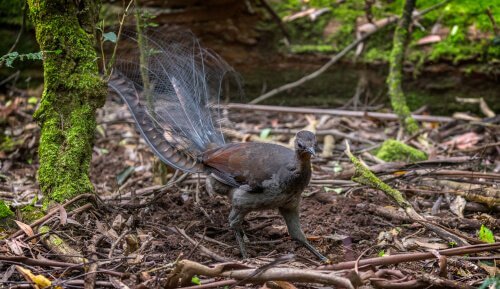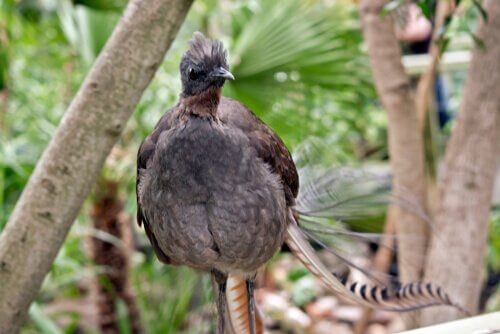The Lyrebird and its Amazing Abilities

The majestic and superb lyrebird, which is native to Australia, is known for its ability to accurately reproduce any kind of sound. People’s fascination with this animal has led numerous scientists to use this bird for research and documentaries.
The lyrebird: habitats and characteristics
This bird’s scientific name is Menura novaehollandiae and it’s from the Menuridae family. It’s very large and can reach up to one meter in length. Consequently, it’s one of the largest songbirds in the world, behind the thick-billed crow and the common raven. Usually, they live in the Australian forests of Queensland and Victoria.

This bird gets its name from the appearance of its feathers and its tail; when they’re stretched out they look like a lyre. After seven years of age, the males will use their majestic tails, that have feathers that reach up to 55 centimeters, to attract females. During mating season, each pair will usually produce an egg. Their mating ritual includes the male dancing and wagging his tail to dazzle the female.
Although this bird’s brain is tiny, it can imitate sounds extremely well. These include the complex song of the kookaburra and even the sound of a chainsaw. The lyrebird can imitate the sounds of up to 20 different bird species. However, they are also expanding their repertoire to include sounds created by man. Because of this, there is a lot of confusion among the native population.

The lyrebird on TV
David Attenborough, one of the greatest naturalists of all time, included this bird in his documentary The Life of Birds. He used several scenes that showcased a lyrebird fully demonstrating his singing abilities. Not only was it imitating the other birds, but it could also imitate the sounds of the camera perfectly.
Ornithologists have studied the structure and evolution of birds’ vocalizations. They were trying to correlate the evolution of its different types of song along with aspects like sexual selection or the species’ immediate environment. Also, as a passerine bird or a songbird, the lyrebird often expands its repertoire to attract as many females as possible, and to defend its territory.
The majestic and superb lyrebird, which is native to Australia, is known for its ability to accurately reproduce any kind of sound. People’s fascination with this animal has led numerous scientists to use this bird for research and documentaries.
The lyrebird: habitats and characteristics
This bird’s scientific name is Menura novaehollandiae and it’s from the Menuridae family. It’s very large and can reach up to one meter in length. Consequently, it’s one of the largest songbirds in the world, behind the thick-billed crow and the common raven. Usually, they live in the Australian forests of Queensland and Victoria.

This bird gets its name from the appearance of its feathers and its tail; when they’re stretched out they look like a lyre. After seven years of age, the males will use their majestic tails, that have feathers that reach up to 55 centimeters, to attract females. During mating season, each pair will usually produce an egg. Their mating ritual includes the male dancing and wagging his tail to dazzle the female.
Although this bird’s brain is tiny, it can imitate sounds extremely well. These include the complex song of the kookaburra and even the sound of a chainsaw. The lyrebird can imitate the sounds of up to 20 different bird species. However, they are also expanding their repertoire to include sounds created by man. Because of this, there is a lot of confusion among the native population.

The lyrebird on TV
David Attenborough, one of the greatest naturalists of all time, included this bird in his documentary The Life of Birds. He used several scenes that showcased a lyrebird fully demonstrating his singing abilities. Not only was it imitating the other birds, but it could also imitate the sounds of the camera perfectly.
Ornithologists have studied the structure and evolution of birds’ vocalizations. They were trying to correlate the evolution of its different types of song along with aspects like sexual selection or the species’ immediate environment. Also, as a passerine bird or a songbird, the lyrebird often expands its repertoire to attract as many females as possible, and to defend its territory.
This text is provided for informational purposes only and does not replace consultation with a professional. If in doubt, consult your specialist.








